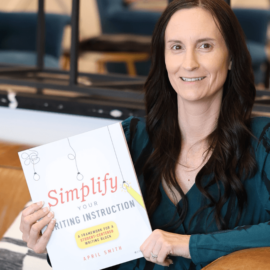Primary project-based learning is awesome!
A common question I get is: Can primary teachers do project-based learning? My answer is wholeheartedly, YES! Most primary teachers are already doing thematic units with their students, so it’s not a huge jump into project-based learning. If you’re interested in PBL in your primary classroom, this post is for you!
The more hands-on, the better.
Primary students need to move around and explore their surroundings. Project-based learning at the primary level should allow them to learn more about something they’re interested in by reading about and exploring the topics. It should include tangible things they can experience with their five senses.
Their end products should be hands-on as well. Allow them to show their learning using what they’re interested in. Check out this economics example from Heather M.’s classroom, where her students opened their own small businesses. Can you tell what this student is interested in from her end product? Absolutely!

PBL in the primary grades is very guided.
Many teachers think that project-based learning is a very canned lesson structure that has to be 100% student-driven, with no teacher guidance whatsoever. This is absolutely false. The level of independence in PBL isn’t mentioned in the essential elements, because it’s not a set amount. It’s important for students to have input in the project, and to be working on something that drives them. However, if you have to guide your students through, that doesn’t make it an inauthentic PBL.
At the primary level, PBL often has a whole-group output. The students contribute through learning and discussion, and they help create something for the output. It’s a team effort. This is especially true in K-1 classrooms.
Check out this class output from Beth B., a kindergarten teacher:

My kindergarten class, and I, are almost at the end of our quarter-long project about honeybees. We have done a lot of reading, writing, observing, tasting, and sketching. Today, we started working on our 3D model of our school’s observation beehive. Tomorrow, we will start adding bees in various stages, honey, wax caps, and more. A coworker’s husband built the structure using frames from an old beehive. If we weren’t at the end of the school year, I would have had the kids cut the wood.
Failure is ok.
Have you ever had a lesson fail? My answer is yes, many, many times. I’ve had lessons fail with regular direct instruction, worksheets, and project-based learning. If you’ve ever had a lesson fail, you know that reflection is so important.
Failing seems to happen a lot in project-based learning. Why? Because you and your students are trying out new ideas that haven’t been tested yet. You’re making a lot of mistakes, which lead into a great discussion and in-depth inquiry. Sometimes projects start to spiral out of control and we wonder where we took a wrong turn.
That, my friends, is how life works. The skills your students will learn from failing are much more valuable than becoming good standardized test takers.
Testing is not an issue.
On that note, let’s discuss an excuse teachers use to do endless amounts of worksheets (this was me at a point, so don’t take offense). Tests. Your students will retain way more information through project-based learning because they are learning through doing. Any skills you think they need on the test can be incorporated into your PBL.
Critical thinking is an important test skill. Have you ever done test prep worksheets for weeks, only to see that the questions are worded totally different on the test? That’s because this direct teaching only prepares them for one question structure. It doesn’t encourage them to think analytically. If they have actually experienced what the question is happening, and used it in an authentic way, they’re more prepared for any way the question is worded.
Help is appreciated.
You’re going to want help and support as you tackle your first PBL. Send home letters to parents telling them what you’re working on and ways they can help, in class and at home. Many parents may not be able to take time off of work to visit your classroom and offer help, but they can work with their child at home by answering questions and continuing the in-depth inquiry. Make a list of things they can do at home to support the project. I do this instead of homework, and my students and parents appreciate that.


